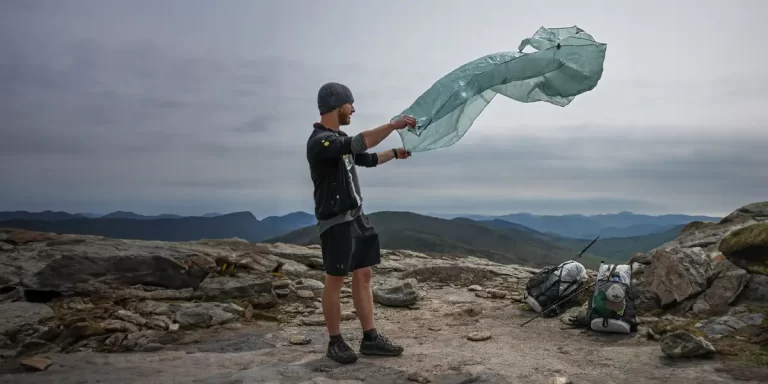

As daylight fades into dusk and the wilderness whispers its secrets, our shelter – the tent – becomes our haven.
But amidst this narrative of outdoor exploration, a less-discussed companion emerges – the tent footprint.
The pivotal question arises – do you need a tent footprint? Is it one of those camping essentials?
Tent footprints are like shields for your tent’s floor. They’re made from materials, such as thick nylon or polyester, and they sit between the ground and your tent.
Their job? To keep your tent safe from all things that might try to harm it.
Imagine the ground is a bit rough with rocks, sticks, or even damp earth. If your tent’s floor directly touches these, it can get scratched, torn, or damp. That’s where the tent footprint steps in. It takes the hits, so your tent doesn’t have to.
Now, let’s uncover why tent footprints are more than just fabric. They offer real advantages for your camping experience:
But remember, while footprints provide valuable shelter floor protection benefits, their role is not intended to provide insulation.
When shopping for a tent footprint, consider the following key attributes:
Some excellent footprint options are the Zpacks Flat Groundsheet and Gossamer Gear Polycryo (Tent Footprint) Ground Cloths.

For those of us who enjoy exploring the wilderness with a lightweight backpack, every ounce becomes significant. This leads us to a dilemma: Should you concern yourself with a tent footprint?
Let’s look at typical weight ranges for some common footprint materials:
Tyvek Footprints:
Polycryo Footprints:
Silicone-treated Polyester (SilPoly) or Custom Footprints:

First and foremost, you should consider your hiking and camping environment. If you frequently camp on soft sand or grassy meadows, footprints may not be essential.
However, in rocky or rugged areas, a footprint can be a tent-saver, as a single sharp rock could cause serious damage to your tent’s floor, and a footprint should be on your camping checklist.
Ask yourself these questions; if you answer “NO” to any of them, bring a footprint:
If you answered “YES” to these questions, a footprint may not be a must amongst your camping equipment.
It’s important to properly care for your tent footprint so it continues protecting your flooring for many trips:
Cleaning:
Repairs:
Prolonging Material Life:
Storage:
In conclusion, tent footprints are crucial camping accessories and not just pieces of plastic for added camping convenience. Despite adding some weight to your pack, footprints protect your tent from damage and act as a shield against wet conditions.
With proper care, footprints can last through numerous camping trips, extending your tent floor’s lifespan and saving you money. Consider the trade-off of a few extra ounces for added protection, based on the earlier questions, and make the right choice for yourself.
Happy camping!
Interested in an ultralight tent that might already have a footprint? Check out our TOP 5 guides that cover the lightest tents on the planet.
If you want to make your own DIY footprint, check this nifty guide here. For other camping tips check out our insights section.
Apart from a traditional tent footprint, you can consider using materials like Polycryo or Tyvek, as well as a tarp as alternatives. This falls into the category of good camping hacks as they protect your tent’s floor while being lightweight and convenient to carry.
It’s generally recommended that a tent footprint should be slightly smaller than the tent’s dimensions. This prevents water from collecting between the footprint and the tent’s floor, helping to maintain a dry and comfortable interior. It’s a good camping safety measure for added camping comfort.
A tent footprint provides protection, but isn’t always a must have camping . For softer surfaces like grass or sand, the risk of floor damage is low. However, in areas with rocks, sticks or rugged terrain, a footprint can prevent punctures and extend your tent’s life. Consider the trip location and whether occasional wear is a concern to decide if a footprint makes sense for that particular outing.
Most tent footprints are constructed to exactly match your tent’s dimensions. Position it under the tent floor so that the perimeter edges align. Some have loops, ties or stake points to secure it in place to prevent shifting. These attachment points should be engaged around the entire footprint perimeter. A bit of good camping advice is that you can also use loose stakes or trekking poles through hemmed edges as anchors during setup for additional security.
Footprint prices vary depending on material, thickness, size and brand. Expect to spend $20-60 for most standard-sized footprint options. DIY Tyvek or Polycryo prints can be made for around $10-20. Higher-end specialty footprints using durable fabrics like SilPoly may range from $60-100. As with any camping gear purchase, consider how often you camp and your tent’s value when determining if an investment in a quality footprint makes financial sense for protecting a floor over years of use.